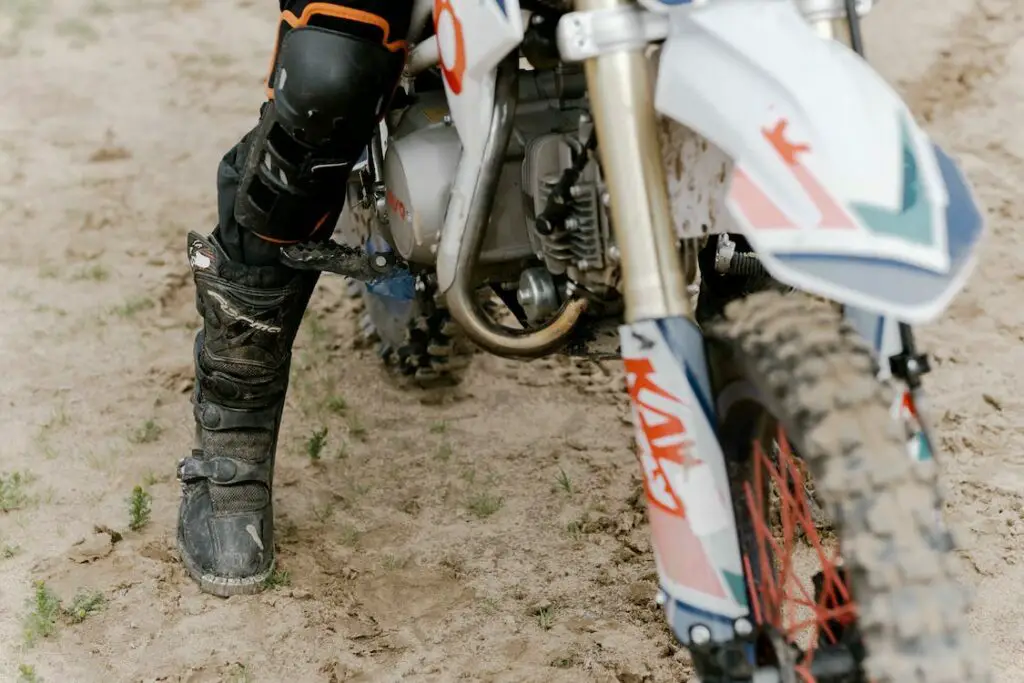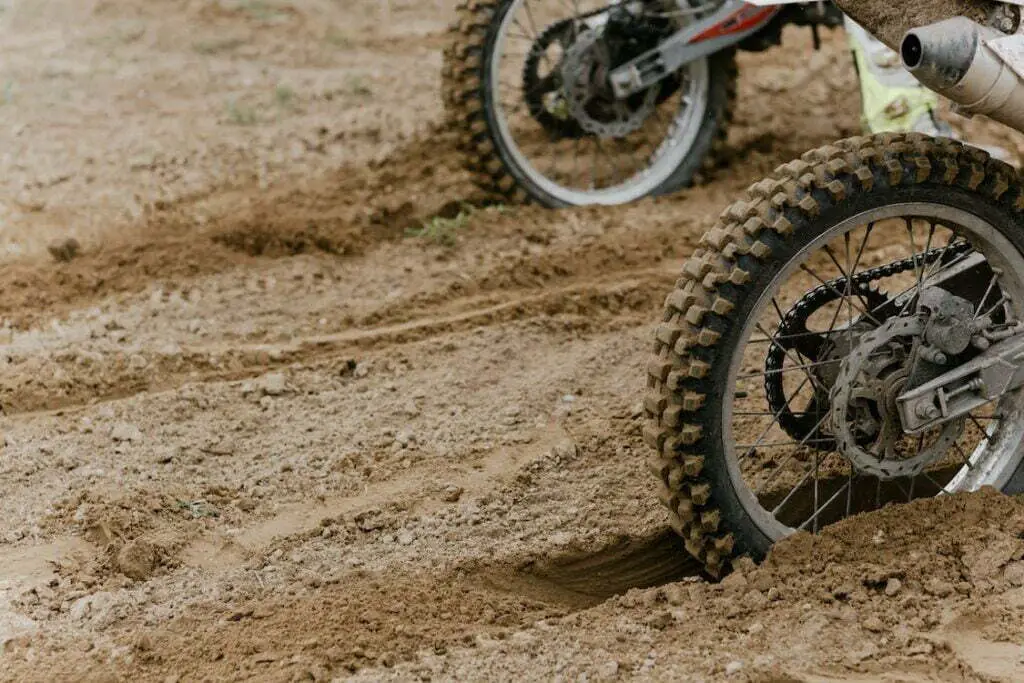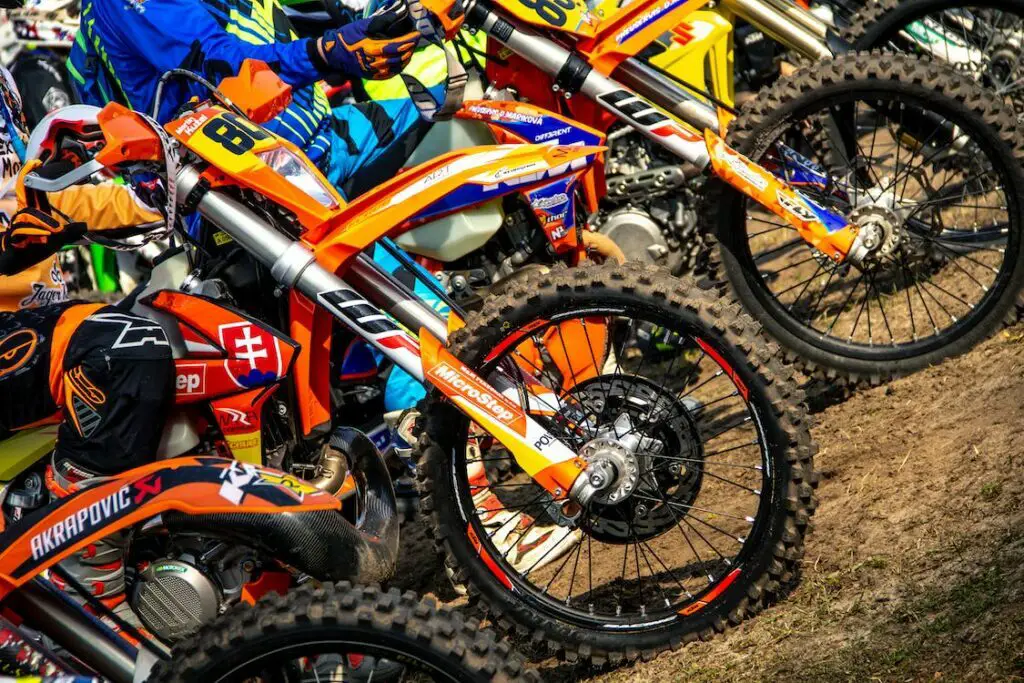Many of us have experienced the nasty consequences of a kickback when starting a dirt bike with a kickstart. Just like you, I was curious what causes the kickback and how to prevent it.
Dirt bike kickstart kickback happens when the piston has not reached top dead center (TDC) during the kick. The spark ignites the fuel mixture in the piston and causes the engine to rotate in the wrong direction. Kickback is not common and mainly occurs in two stroke bike engines with air cooling.
How To Prevent Kickstart Kickback
Kickback is a known issue among the dirt bike community but it is not common in brand new and well maintained bikes.
Let me explain.
Bikes straight out of the factory are well tuned and set up to ride out of the box (here we are talking about reputable brands like Honda, KTM, Yamaha and so on).
Every part of the bike, including the engine, has been rigorously tried and tested to provide high reliability and performance.
Therefore, kickback is more common in bikes that have engines that were incorrectly rebuilt or have been knocked around so much that they start having issues.
Due to slight (or not so slight) changes in engine component settings, the engine timing can become advanced or retarded (more on that later).
Now that we understand the primary cause of the kickback in dirt bikes, let’s take a closer look at how to prevent it.
There are a number of solutions used by the dirt biking community across the globe, and I have listed them below in the order of difficulty (the more technical solutions are listed last).
Use Proper Starting Procedure (easy)
This is the very first thing you should try, especially if you are new to motorcycles.
Caution!
ALWAYS wear your riding boots when starting the bike, even if it is in your garage for maintenance – kickback in larger bikes can literally send you flying over the handlebars.
Obviously, you do NOT want to experience kickback while wearing sneakers or flip-flops.
Ok, with our Health & Safety briefing done, let’s get to the actual solution – the correct starting procedure (if you’ve been riding for a while then you can skip to the next section, as you most likely know how to start the bike properly).
1. Fuel On
Turn on the fuel by switching the gas line valve to the “on” position.
This valve is located near the engine, just below your seat.
In some bikes it has two settings – “ON” and “OFF”, while in others it can also have the third reserve or “RES” setting.
2. Choke Open
If you’re starting cold, open the choke by pulling it upwards.
The choke can look like a button or like a lever and is located close to the engine (check your bike manual for the exact location).
No need to use the choke if you’ve been riding all day and the engine is hot.
3. Gear Neutral
Ensure your bike is in neutral gear.
Do this by engaging the handlebar clutch lever with your left hand and tapping down on the gear lever with your left foot several times – this will put your bike into 1st gear.
Then, while holding the clutch with your hand, push the gear lever upward softly with your foot until you feel a soft click – this is neutral.
You can easily check that you’re in neutral by releasing the clutch lever and rocking your bike back and forth.
If you’re in any gear apart from neutral your bike won’t roll (feels kind of like forgetting the handbrake on in your car).
When kicking your bike, make sure you stay clear of the clutch and gear lever so you don’t change gears by accident.
4. Prime Carb
If you are riding a 4 stroke bike, you might need to prime the carburetor with fresh fuel.
This is done by fully opening the throttle (twisting the handle towards you) and letting it go to snap back in place.
Do this 2-3 times but then don’t touch the throttle until you start the bike.
A well known trick that is more relevant in older bikes, usually made in the year 2000 or older.
If you’re riding a newer 4 stroke bike, or a 2 stroke bike, you can skip this step.
5. Get TDC
Pull out the kickstarter with your hand and place the middle of your foot firmly over the kickstart pedal (make sure you’re wearing riding boots).
Gently push down a few times (right now you’re not kicking to start yet, just finding the right spot for the kick).
You will feel the pedal go down softly a few times before becoming tense.
The right spot is when you feel the most resistance in the pedal, when it is in the upright position.
6. Kick It!
With your left foot firmly on the ground for good balance, give the kickster a strong push with your right foot, putting some of your weight into it.
Don’t jump on the pedal with all your weight as you might lose balance and tip the bike over. If the bike doesn’t start on the first kick, go back to the previous step to find the sweet spot and try again.
Most bikes tend to start on the first couple of kicks.
Use Higher Octane Fuel (easy)
There is a saying in the dirt bike community that goes something like “dirt bikes are tough and will run on vodka if they need to”.
All humor aside, your user manual has a certain octane number that is recommended for your specific model.
A side note – keep in mind that the US uses AKI octane number, and Japan uses RON octane number for fuel, so make sure you cross-reference the two numbers to get the right fuel (so US octane number is 4-6 points lower than in Japan for exact same fuel).
A higher octane fuel burns a bit quicker and cleaner, and has been proven to eliminate kickback in dirt bikes that have engine sizes of 130cc and upwards.
This is more of an art than science to see what gas your bike works best with.
I would recommend starting with gas that is one grade higher than stated in your manual, as buying the most expensive high octane fuel will most likely be a waste of money for what it is.
Adjust Ignition Timing (technical)
There are two ways of doing this – adjusting the timing manually and using an aftermarket CDI box (both methods are explained below).
Manual Adjustment
Aside from routine spark plug replacements, a CDI-type (Capacitor Discharge Ignition) system, that most dirt bikes use, needs extremely minimal maintenance under normal conditions.
Using a moveable coil plate, certain bikes provide some ignition timing modification, changing the points at which the source and pickup coils are activated.
The ignition coil should ideally be started by the pickup coil immediately before the engine’s piston completes its stroke.
The timing is advanced and a spark is produced more quickly when the plate is moved counterclockwise to the flywheel’s direction of rotation (too much advance can result in engine knocking).
Alternatively, if you move the plate in the same direction as the flywheel, the timing is slowed down and the spark is produced later (too much retarding can cause power loss).
The timing position in relation to the position of the piston will be marked along the edge of the coil plate.
Here is an awesome video that explains this concept really well.
Just a word of caution.
You should only attempt this solution if you’re comfortable with mechanical repairs, and do this at your own risk as incorrect settings can result in permanent motor damage and/or personal injury.
Use Aftermarket CDI Box
In a lot of smaller bikes (e.g. 130cc, 150cc) an aftermarket CDI coil can prevent kickstart kickback.
There are readily available solutions in the US market, such as TRC EZ Start High Performance CDI.
The aftermarket CDI box advances the timing as the engine increases revs – the higher the revs, the more advanced is the spark.
This video shows a generic process of installing an aftermarket CDI on a bike.
Summary
Today we had a look at several things you can try to prevent your bike kicking back.
The easier ways were to try a higher octane fuel and to check how you start your bike.
The more technical solution was to check ignition timing, and tweak it slightly if needed.
There is always another solution that works nearly every time – take your bike to the local mechanic (although this one might be the most pricey too).
Whatever you choose to try, remember to stay safe, and good luck!



